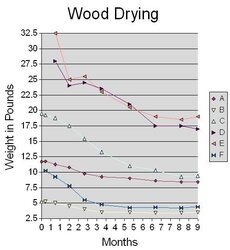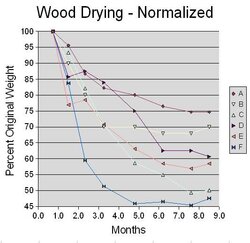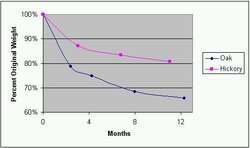I did a study of how long it takes my wood to dry under my local conditions. I took a number of pieces of wood in different formats, and weighed them every month or so. This is the wood:
A - Spruce (or maybe fir?)
B - Spruce smaller piece
C - Pine shorter log, unsplit
D - Pine longer log, split
E - Pine longer log (matched to D), split
F - 2006 log split, that had dried and then gotten wet again (months in the rain)
The picture shows this wood, and the graph shows how their weights changed over time. 0 = Jan 20, 2007. The relative humidity around here (far northern California coast) is very high.
My conclusions:
1. It takes my wood about 5-6 months to dry (reach an equilibrium)
2. The split wood did not dry any faster than the non-split (this was a surprise)
3. The wood that had dried then become wet took just as long to dry
A - Spruce (or maybe fir?)
B - Spruce smaller piece
C - Pine shorter log, unsplit
D - Pine longer log, split
E - Pine longer log (matched to D), split
F - 2006 log split, that had dried and then gotten wet again (months in the rain)
The picture shows this wood, and the graph shows how their weights changed over time. 0 = Jan 20, 2007. The relative humidity around here (far northern California coast) is very high.
My conclusions:
1. It takes my wood about 5-6 months to dry (reach an equilibrium)
2. The split wood did not dry any faster than the non-split (this was a surprise)
3. The wood that had dried then become wet took just as long to dry





